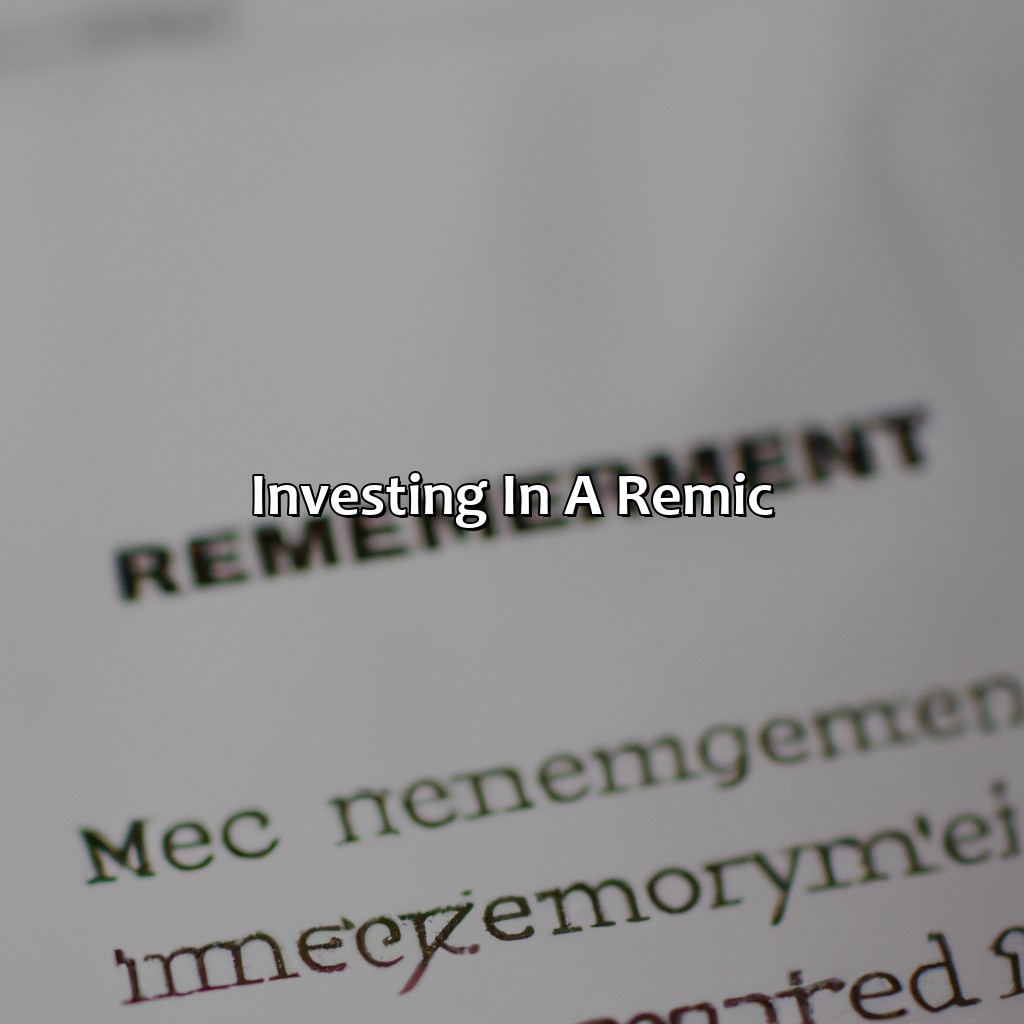What Is A Real Estate Mortgage Investment Conduit?
Key Takeaway:
- Real Estate Mortgage Investment Conduit (REMIC) is a type of investment vehicle that pools mortgages and issues multiple classes of securities, using pass-through taxation to distribute profits to investors.
- REMICs offer advantages such as diversification, steady cash flow, and potential tax benefits, but also come with risks such as interest rate and prepayment risks, as well as the potential for default by the underlying mortgages.
- To invest in a REMIC, an investor must meet certain requirements, such as being an accredited investor and having access to a broker or dealer. Due diligence is also necessary to assess the creditworthiness of the underlying mortgages and the performance of the REMIC.
Are you curious about the real estate investment process? Discover what a Real Estate Mortgage Investment Conduit (REMIC) is and how it works with our helpful guide. Learn the advantages and disadvantages of this popular investment vehicle and how it could benefit you.
Characteristics of REMIC
REMICs are investment vehicles that offer advantages in the real estate market. Here are some key features of this investment type:
| Characteristics | Details |
|---|---|
| Tax status | REMICs are classified as pass-through entities |
| Cash flow | The payments are made to investors quarterly |
| Pooling of assets | REMICs are created by pooling assets |
| Direct ownership | Investors have direct ownership of the underlying |
| Limited liability | Investors’ liability is limited to their investment |
| Diversified risk | REMICs distribute investments across various assets |
| Prepayment penalties | REMICs usually have no prepayment penalties |
It is important to know that REMICs are typically backed by mortgages rather than physical properties. REMICs also have strict requirements to qualify for tax benefits, such as meeting asset diversification and distribution requirements.
In the early 1980s, the first REMICs were created as part of a government effort to promote private investments in the real estate market. Since then, REMICs have become a prevalent tool for investing in mortgages and increasing liquidity in the real estate market.

Image credits: retiregenz.com by Yuval Woodhock
Formation of REMIC
The process of organizing a Real Estate Mortgage Investment Conduit (REMIC) involves the creation of a pool of mortgages to be securitized and transferred to a trust. This trust issues series of securities backed by mortgage loans. The Internal Revenue Service (IRS) has specific requirements for creating a REMIC.
To form a REMIC, an entity must establish a trust and transfer at least one mortgage to it. The trust must satisfy the IRS’s criteria for being a REMIC. The transferred mortgages must be properly documented, and the trust must ensure that it meets the 95% asset test requirement. The structure of a REMIC allows it to issue multiple tranches of securities, each having different levels of risk and returns.
It is important to consult a professional during the formation of a REMIC, as failure to meet the IRS’s requirements may lead to significant tax penalties and the loss of REMIC status. Additionally, the REMIC must adhere to various regulations governing the management of the trust and reporting requirements.
To ensure successful formation of a REMIC, one should consider:
- working with a knowledgeable attorney familiar with the legal requirements,
- consulting with a tax professional to ensure all tax implications are well understood,
- carefully reviewing all documentation before submission.
By adhering to these suggestions, a REMIC can be successfully formed, bringing many benefits to the investors and issuers alike.

Image credits: retiregenz.com by Harry Jones
Investing in a REMIC
Investing in a REMIC involves purchasing securities issued by a Real Estate Mortgage Investment Conduit. Here is a breakdown of what you need to know before investing:
| Investing in a REMIC | |
|---|---|
| What is it? | A pool of mortgages that are packaged into securities and sold to investors. |
| How does it work? | The mortgage payments from the pool of loans are used to pay interest to the investors. |
| What are the risks? | The performance of the underlying mortgages will affect the value of the securities. |
| Who can invest? | Individuals, corporations, pension funds, and other institutional investors. |
It is important to note that REMICs offer unique investment opportunities, but they also come with risks. Before investing, it is crucial to fully understand the potential risks and rewards.
Investing in a REMIC can be a wise decision for those seeking diversification in their investment portfolio. However, it is important to conduct thorough research and seek professional financial advice before making any investment decisions. Don’t miss out on potential opportunities, but always invest wisely.

Image credits: retiregenz.com by James Jones
Five Facts About Real Estate Mortgage Investment Conduit (REMIC):
- ✅ A Real Estate Mortgage Investment Conduit (REMIC) is a type of special purpose vehicle (SPV) used to hold a pool of mortgages. (Source: Investopedia)
- ✅ REMICs are used to issue mortgage-backed securities (MBS), which are traded on the open market. (Source: The Balance)
- ✅ A REMIC can be structured to provide different levels of risk and return to investors. (Source: Mortgage News Daily)
- ✅ To qualify as a REMIC, a trust must comply with certain requirements, including the distribution of at least 90% of its income to investors. (Source: Internal Revenue Service)
- ✅ REMICs played a significant role in the 2008 financial crisis, as many mortgage-backed securities were found to be overvalued and of poor quality. (Source: Harvard Business Review)
FAQs about What Is A Real Estate Mortgage Investment Conduit?
What is a real estate mortgage investment conduit?
A real estate mortgage investment conduit (REMIC) is a type of special purpose vehicle (SPV) that holds a pool of mortgage loans secured by real estate properties. The REMIC issues mortgage-backed securities (MBS) to investors, and the cash flows from the mortgage payments are distributed among the investors according to the terms of the securities.
Who can invest in a real estate mortgage investment conduit?
Anyone who wants to invest in the real estate market can invest in a REMIC, provided they meet the eligibility criteria set by the issuer. Typically, institutional investors like banks, pension funds, and hedge funds invest in REMICs. However, individual investors can also invest in REMICs through mutual funds or exchange-traded funds (ETFs) that hold REMIC securities.
What are the benefits of investing in a real estate mortgage investment conduit?
Investing in a REMIC can provide diversification benefits to investors by allowing them to invest in a large pool of mortgages with different characteristics. Additionally, REMIC securities are typically rated by credit rating agencies and offer varying levels of credit risk and yield, allowing investors to choose the level of risk and return that suits their investment goals.
What are the risks associated with investing in a real estate mortgage investment conduit?
The risks associated with investing in a REMIC depend on the specific securities being offered. Generally, REMICs are subject to interest rate risk, credit risk, prepayment risk, liquidity risk, and market risk. Additionally, changes in the real estate market or regulatory environment can impact the performance of REMICs.
How are real estate mortgage investment conduits taxed?
REMICs are treated as pass-through entities for tax purposes, meaning they are not subject to federal income tax. Instead, the income generated by the REMIC is passed through to the investors, who are responsible for paying taxes on their share of the income.
How are real estate mortgage investment conduits structured?
REMICs are structured as a series of different classes of securities, each with different levels of credit risk and yield. The securities are typically grouped into tranches based on their payment priority, with the most senior tranches having the highest payment priority and the lowest risk, and the most junior tranches having the lowest payment priority and the highest risk. The cash flows from the mortgage payments are used to pay the interest and principal on the securities in order of their payment priority.
